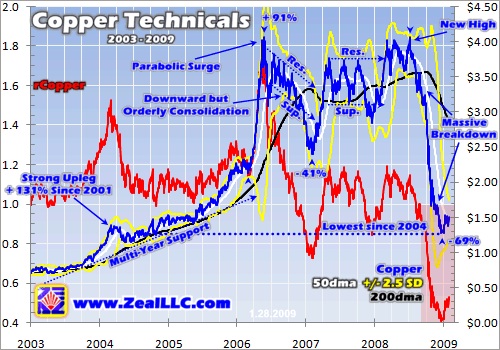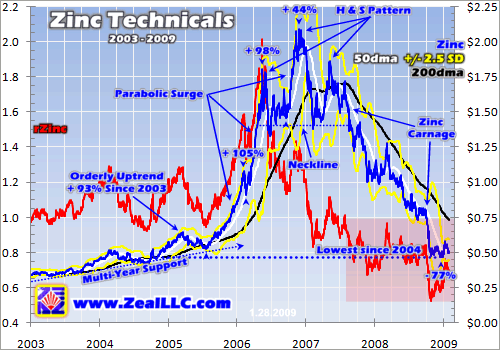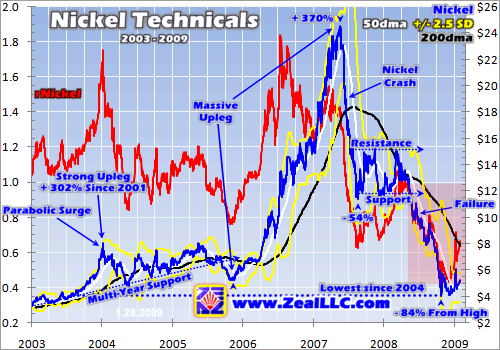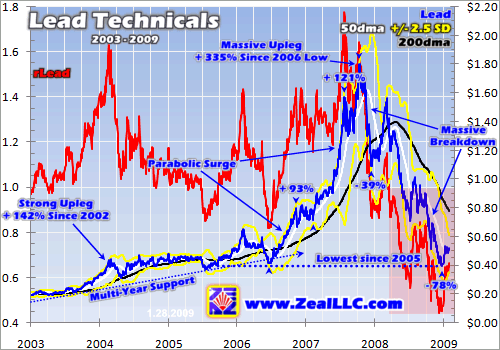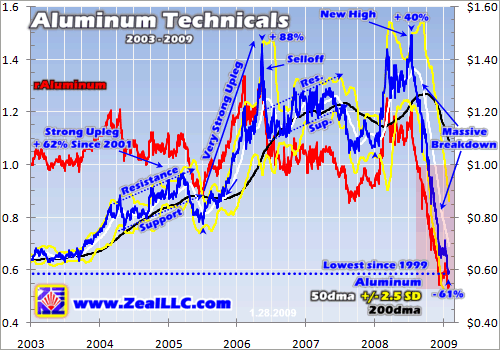|
|
|||||||
|
|
|
|
|
|
|
|
|
|
Base Metals Technicals 5 Scott Wright January 30, 2009 3477 Words
Not too long ago base metals were the hottest of commodities. In their bull markets the prices of these industrial-use metals had soared to lofty heights to reflect the speculative risk premiums brought on by greatly imbalanced markets. Copper, zinc, nickel, lead, and aluminum achieved staggering trough-to-peak gains of 574%, 523%, 1124%, 829%, and 151%!
A mixture of robust infrastructure growth and hoarding led to demand far outpacing supply. Global stockpiles were being drained to alarmingly-low levels, the worldís smelters and refineries were operating at full capacity, and the mining companies couldnít bring their metals to market fast enough.
Bullish fundamentals and exuberant speculators lifted base metals prices to all-time highs. And investors couldnít go wrong buying the stocks of the base metals explorers and producers. In this world of base metals bliss the sky was the limit on how rich these non-ferrous beauties could make you.
But oh how things can change in such short order. The stock panic of 2008 wreaked havoc on virtually every asset class, and the base metals were not immune to the carnage. Already within corrective environments, the stock panic has bled the base metals to dangerously unhealthy levels. Copper, zinc, nickel, lead, and aluminum have seen respective declines of 69%, 77%, 84%, 78%, and 61% from their recent highs.
These losses have been devastating for investors and speculators who had positions in anything base metals related. For each of the big-five metals these sharp declines have lopped off not only the speculative premiums but several years worth of gains. And as Iím sure youíve heard by now, the price action of these metals is drawing Great Depression-like comparisons.
Well before I expound on this parallel and discuss what the future might hold for these metals, it is prudent to assess their technicals. Anyone with any interest in base metals ought to gain a foothold on the evolution of their bull markets. And there is no better way to capture the essence of these bulls than to view them in visual chart format.
Considering the massive gains the base metals have had in such a short period of time there is no doubt theyíve experienced extreme volatility. And this volatility has occurred both on the upside and the downside. The last time I looked at their technicals, near the end of 2007, most of this volatility had an upside bias. But the violent downside action of recent has been something to behold.
A 6-year chart of copper, the base metals bellwether, encapsulates the volatility seen in the base metals bull markets in recent years. But extreme volatility hasnít always been prevalent. In fact, for the most part the beginning of these bulls played out in orderly fashion.
Copperís low point of $0.60 occurred in late 2001, but its bull didnít pick up steam until 2003. And an impressive upleg saw copper more than double to its high in Q1 2004. After it achieved this interim high copperís price action acted out prototypical bull-market behavior. A multi-quarter sideways consolidation served to shed excessive greed, followed by copper easing right back into its uptrend.
As you can see copper carved out a beautiful uptrend with multi-year support in the first half of its bull market. But coming into 2006, all sense of order would vanish. When it became apparent that China was systematically ravaging the copper supply, fears of actually running out would emerge. And this opened the doors for a long season of extreme volatility.
Copperís wild early-2006 parabola put it on the map for mainstream investors. Any time an asset launches 91% in only 60 trading days it is sure to capture folksí attention. And from this 2006 high over $4.00, copper would spend the next two years volleying around with whipsaw-like ferocity.
Interestingly, it was during this period of time that copperís price would exhibit an incredibly tight inverse correlation with LME stockpile levels. LME stockpiles are the foremost measures of aboveground inventory for the base metals. So when they fell to levels that were the equivalent of mere days of global daily consumption, huge risk premiums would be placed on the metalís price to reflect what was a widening economic imbalance.
In a series of past essays and in the subscriber charts section of our website we update LME stockpile and price charts for the base metals. And the visual depiction of this relationship is quite compelling.
For copper it was movements down to the 100k metric-ton range that cast fear into the minds of traders. Every time copper stockpile levels approached 100k metric tons over the last several years its price would rocket higher. The inverse applies as well. In fact, it was a build that more than doubled LME stockpiles entering into 2007 that was the impetus for copper to fall 41% over that same span of time.
Well with 2008ís stock panic infecting the entire global economy, a radical shift in base metals fundamentals has been quick to decimate copper. With demand growth quickly slowing and then shifting to declining, supply quickly caught up and the supply-deficient imbalance all but disappeared.
Since September LME copper stockpiles have more than doubled and a sky-is-falling type scenario has played out in copperís price. It has plummeted 69% since its July high to levels not seen since 2004. In a massive breakdown that was accelerated by the stock panic, copper has experienced a technical bloodbath.
Even though copper is still up 144% since the beginning of its bull, its relative performance has been abysmal. The red shaded areas in these charts represent the relative trading zones that are currently under par. At Zeal we use relativity to measure where the price of an asset is relative to its 200-day moving average, calculated by dividing the current price by its 200dma.
In bull markets prices tend to outpace their 200dmas on balance, quite logical with upward-moving prices. And in copperís case you can see that it has spent most of its time above its 200dma, or 1.0 on the red line. But in this panic we are seeing relativity levels at extreme lows. The price of copper has fallen so hard and so fast that it is way below its 200dma.
Looking at the rest of the base metals you will see a similar picture. Zincís bull also started out in orderly fashion. From its 2003 low zinc gradually rose higher, bolstered by multi-year support, gaining an impressive 93% to its high in the first half of 2005. But like copper, order left the building when a subsequent series of parabolic ascents launched zinc stratospheric.
As with most of the base metals, rapidly growing zinc demand would pilfer global stockpiles down to dangerously-low levels. Zincís aboveground inventory was ravenously devoured by hungry consumers that couldnít get enough of it. And this growing supply/demand imbalance placed huge speculative risk premiums on zincís price.
With zinc stockpiles rapidly falling, a mid-2005 to early 2006 parabolic surge saw the price of zinc double in just 140 trading days. Then after a quick respite zinc doubled again by May, this happening over only 58 trading days.
By late 2007 LME zinc stockpiles had fallen by over 90% to less than 100k metric tons, leaving the equivalent of only two days of daily global consumption available to consumers. And after another quick surge of 44% in only 48 trading days zinc had achieved all-time highs, briefly trading at a once-inconceivable $2.00+.
As you can see, zincís late 2006 apex is flanked on both sides by lesser but also sharp pops that formed a classic head-and-shoulders pattern. The right shoulder reflects a brief rally off the sharp correction from the high, but it quickly faded and fell down to form the infamous neckline that would prove to be zincís doom.
Unfortunately this type of pattern is common in the chart-technician world as a trend-reversal pattern, very bearish. At the time I was hopeful that zinc would beat the odds since its LME stockpile levels were at record low levels, but it decisively broke through the neckline to the downside and proceeded to plunge to the levels we see today.
Zincís decline accelerated into 2008 as suppliers were finally able to meet demand. And LME stockpile levels have continually risen since the beginning of 2008, more than quadrupling. With the imbalance swinging to a supply surplus zinc was already in the midst of a healthy correction by the time the stock panic hit. But the stock panic was quick to add to the pain, driving zinc to levels not seen since 2004.
Even though zinc is still up 48% since the beginning of its bull market, a 77% decline from its high has placed suppliers and investors in a state of wailing and gnashing of teeth. And the current state of nickel isnít any better. Looking at its chart, this base metal simply oozes volatility.
Nickelís uptrend indeed exhibited multi-year support leading into 2006, but its swings are much more violent. Since the market for nickel is on a much smaller scale than the rest of the base metals, any change in interim fundamentals usually spawns wild volatility.
Nickel got out to a much faster start than the other base metals. Its late 2003 parabolic surge gave it an early bull gain of an impressive 300%. But the fun was only beginning. From its 2005 low nickel took flight in near-linear ascent, driving it to record highs in excess of $20.
This massive upleg was driven by plummeting LME stockpiles that saw nickel inventory fall below 5k metric tons, only one day worth of global consumption. Considering these insanely-low aboveground inventories, speculators attached an enormous risk premium to nickel in an attempt to balance supply and demand.
To its 2007 high, nickelís bull-to-date gain ran an astonishing 1124%. And the incredibly high nickel price eventually served to quell demand and ramp up supply. When nickel stockpiles started to rise in May 2007 the risk premium was quickly lopped off. And in only 63 trading days nickel plunged 54%.
Rounding the corner into 2008 nickel put up a fight and settled into a sideways consolidation, but a further rise in stockpile levels eventually caused nickel to break through support and continue its decline. Already trending down the stock panic eventually joined the party, cutting the price of nickel in half yet again before it finally bottomed in October at levels not seen since 2004. While nickel is still up 161% since its late 2001 low, an 84% decline from the top has really damaged the fortunes for this base metal.
Not deviating from the greater base metals theme, leadís bull market also started out with an orderly uptrend guided by multi-year support. But like nickel, leadís relatively small market is conducive to extreme volatility, both on the upside and downside.
Leadís initial bull run was excellent, gaining 142% in less than two years and surpassing the previous highs from a decade prior. And after the initial surge to its early 2004 high, lead then entered into a long, slightly upward-trending consolidation.
Entering 2006 lead fell behind the pack and bucked the base metals trend. While the other base metals were launching into powerful uplegs, lead fell hard. Interestingly in the first half of 2006 leadís LME stockpiles mounted a huge build, nearly tripling. And the inverse correlation between stockpile levels and price played out beautifully here.
When these stockpile levels eventually turned the corner in mid-2006 and started to plunge, leadís bull stepped into high gear. Its first major run was a quick 93%, 98 trading day, pop from its 2006 low. And then after a short sideways consolidation off the top, lead again launched northward in parabolic fashion more than doubling in price in just 129 trading days.
Over the course of this massive upleg LME lead stockpiles plunged to shockingly-low levels, near 20k metric tons. With only one day of equivalent global daily consumption lead soared to record-breaking levels over $1.80. But as soon as inventories turned upward, leadís premium was quick to fade. And the initial sharp correction of 39% over 44 trading days was the beginning of another massive base metals breakdown.
Lead recovered a bit after this plunge, forming a Quasimodo-type head-and-shoulders pattern, but it quickly broke down. With the stock panic assisting in the latest terminal descent, by the time all was said and done lead had shed 78% off its 2007 high. Interestingly leadís stockpiles are again bucking the base metals trend and have been falling sharply over the last several months. But prevailing sentiment has thrown up a wall of fear that is preventing leadís price from adhering to the inverse correlation.
Aluminum is last but certainly not least of the base metals. Measured by volume it actually has the largest market of the non-ferrous metals. More aluminum is mined and consumed each year than the four metals above combined. And it is because of this larger market that volatility is not as extreme. In fact compared to the others aluminumís action has been downright boring until recent.
Visually aluminum paints a similar picture to the other base metals. Its strong initial uplegs and the velocity of its gains appear in line with the others. But in reality there is a stark contrast in magnitude. While impressive looking in this chart, the first upleg took about 4 years to eke out a gain of only 62%. Though inspiring in the grand scheme of things, this vastly underperformed the rest of the base metals.
After a bit of a pullback in mid-2005 aluminum then set course for its version of a massive upleg. Now 88% is certainly nothing to turn your head at, but again this vastly underperformed the other base metals. After aluminum achieved its 2006 apex, an all-time high, it then spent the next 2 years or so volleying around in the $1.00 to $1.50 range.
During this time LME aluminum stockpiles were hovering at very low historical levels, reflecting a supply/demand imbalance, but they got nowhere near the dangerously-low levels that the other base metals were experiencing.
Interestingly in the first half of 2008 aluminum was the best-performing base metal. When the performances of most of the other metals were actually negative, aluminum had an impressive run that saw it climb 40% to a new all-time high in July. And this was happening in the face of rising stockpiles.
This abnormal strength was the result of structural issues at many of the worldís largest smelters. But once the ship was righted in the global supply channel, aluminum was in for a doozy of a breakdown. And as you can see it has been in a freefall since its July high, plunging to prices that havenít been seen in 10 years. In only 7 months, aluminumís entire bull market gains have disappeared.
Aluminumís dismal slide caps off a survey of base metals technicals that is simply dreadful. Most of these metals were already in corrective environments as the gaps of years-long imbalances were contracting as a result of demand growth easing and the miners steadily ramping up supply. With these markets coming to somewhat of a balance the speculative premiums were quick to fade and prices fell to more realistic bull-market levels.
But the stock panic has transformed what could have been deemed as healthy corrective environments into hyper-negative panic-driven downward spirals. And the price actions of the base metals do indeed warrant depression-era-like comparisons. In the data I could find, during the Great Depression copper, zinc, and lead saw respective declines of 68%, 62%, and 65%. This depression carnage looks awfully familiar doesnít it?
The problem I have with the depression parallel is two-fold. First, the Great Depression was an economic contraction that in large part was an American phenomenon. Americaís travails infected foreign economies causing the depression to go global. But at that time many of the infected economies lived by the American sword and died by the American sword.
In todayís day and age many countries have stopped being merely the grease in Americaís wheels and have developed robust economies of their own. And the base metals trade also conforms to these changing dynamics. In the depression era a big chunk of the worldís metals demand came from Americaís industrial machine. And consequently the majority of the market makers were American.
Today the base metals trade in a truly global marketplace. Advancements in technology, transportation, and commerce have given a great deal of transparency to this market. And the developing economies outside of America have been driving a large portion of the demand growth.
Second, I strongly disagree with the assertion that we are entering into another Great Depression. In order for this to happen the economy would have to be cut in half over a period of about 4 years. I hardly think this is possible in America, and believe it is even less likely in the global economy. At Zeal weíve done extensive studies in our newsletters to back this up.
Now this stock panic, caused by a near-collapse of the financial markets, has birthed what is turning out to be a nasty recession. And a swift contraction of global economic activity has rapidly altered base metals fundamentals. Demand has fallen off a cliff and all of a sudden many of the base metals have supply surpluses.
Ultimately it may take an extended period of time for supply-side imbalances to settle prices into a logical range. But ex-depression, I believe these depression-like slides are way overdone and have created an environment that may breed another bubble-type atmosphere when the world realizes it still needs base metals.
Base metals prices have fallen so hard and so fast that the mining industry is now faced with a huge problem. In many cases the production costs of these metals are well above where the market prices are. And with mining companies now losing money hand over fist, the only thing left to do is halt the development and production of todayís and tomorrowís base metals mines.
There have been countless anecdotal examples of this playing out in real-time fashion. It seems as though it is a daily occurrence where a mining company either goes out of business, halts the development of a future mine, or cuts production at existing mines.
Some of this is natural, as producers need to adapt to a new price environment, but these exceptionally-low prices are causing companies and projects to fall like dominoes. Too much supply coming off the market too fast will quickly cause another shortage. And when the global economy pulls out of this recession and demand begins to pick up, a broken supply channel will cause a major imbalance in the other direction, thus rocketing prices parabolic once again.
I suspect base metals prices have or will soon find their bottoms. With many producers currently unable to economically mine these metals, prices should rise again soon. Traders will eventually realize that we are not going into a depression and that demand has not fallen to zero.
Now volatility is still likely to be the name of the game for base metals futures and the stocks of the companies that explore and mine them. In the same fashion in which they were overbought they have quickly fallen to a level of being oversold. And there are likely to be violent price swings until this extreme level of fear has subsided.
At Zeal we hold a contrarian belief that the markets are actually poised for a big up year in 2009. And if this is indeed the case the elite base metals stocks that had been aggressively sold off will be among the top-performing stocks in this rebound.
In the November issue of our monthly newsletter at the panic depths we initiated a long-term investment recommendation of one of the worldís top base metals stocks. And now is still a good time to deploy investment capital into this elite company. Subscribe today to see this and other high-potential trade recommendations that are packaged with cutting-edge market research and analysis.
The bottom line is base metals technicals are ugly. The panic-driven percentage declines of the worldís industrial metals indeed warrant depression-like comparisons. But since we are not in a depression I donít believe these end-of-the-world price declines are righteous.
If these insanely low base metals prices are sustained the supply stream will contract to dangerously low levels. And when demand picks back up and the worldís developing economies continue their growth, there will be a reckoning that will ignite yet another bubble-type atmosphere as more and more consumers bid for a constrained supply. We will remain cautious as this recession runs its course, but prudent investors and speculators can position themselves for legendary gains when the base metals become bullish once again.
Scott Wright January 30, 2009 Subscribe |
|||||||
|
|
|
|
|
|
|
|
|
|
|
|
|
|
|
|||

